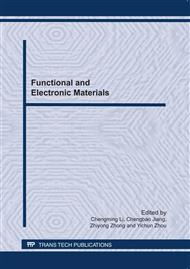p.204
p.209
p.215
p.222
p.228
p.233
p.238
p.242
p.247
(1-x)(K0.475Na0.475Li0.05)(Nb0.975Sb0.025)O3-xBiFeO3 Lead-Free Piezoelectric Ceramics with CuO Sintering Aid
Abstract:
(1-x) (K0.475Na0.475Li0.05)(Nb0.975Sb0.025)O3-xmolBiFeO3 (x=0, 0.002, 0.004, 0.006, 0.008) doped with 0.8mol%CuO lead-free piezoelectric ceramics were prepared by the solid state reaction technique. X-ray diffraction patterns suggested that all the ceramics presented perovskite structure. The compositional dependence of the phase structure and the electrical properties of the ceramics were studied. The ceramic (x=0.002) near room temperature exhibited excellent electrical properties (piezoelectric constant d33=172pC/N, planar electromechanical coupling factor kp=0.43, and dielectric constant =418). A relatively high mechanical quality factor (Qm=200) was also obtained in this particular composition. All these results revealed that this system might become a promising candidate for lead-free piezoelectric materials.
Info:
Periodical:
Pages:
228-232
Citation:
Online since:
June 2011
Authors:
Keywords:
Price:
Сopyright:
© 2011 Trans Tech Publications Ltd. All Rights Reserved
Share:
Citation:


